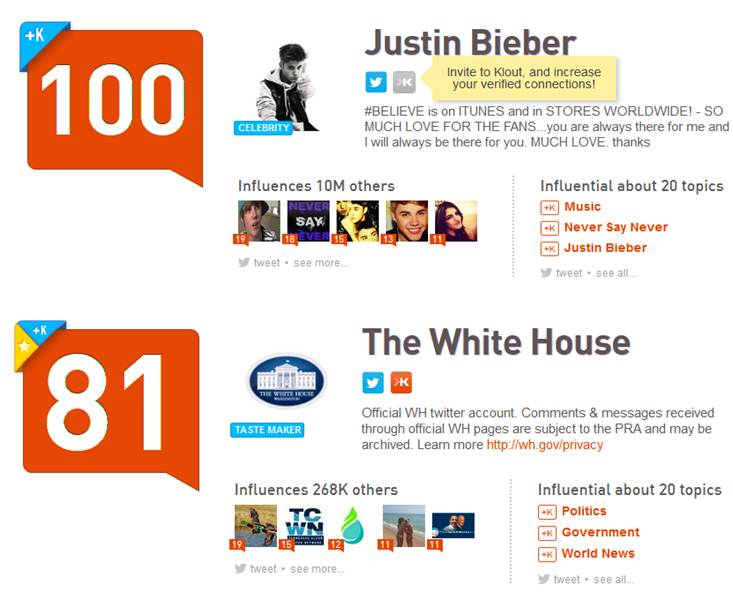“The performance review of the future will include services like Salesforce.com’s Chatter and its Influencers feature, which measures how much weight you carry among your peers”
This is a quote from a recent Fast Company article discussing how enterprise social networks behind corporate firewalls are using Klout-like tools to measure how “influential” you are within your company and it terrifies me. I then read “Enterprise Social Networks, Performance Reviews, and Company Culture,” on the Social Media Club DC blog that rightfully (and thankfully!) takes issue with this idea of ranking people’s influence on these internal networks. I left the following comment there that illustrates why I believe trying to assign influencer scores within the confines of a company’s social network is not only a terrible idea, but that it can virtually torpedo any chance that that network has of being successful.
“People like things like Klout because they ostensibly allow you to stop wasting all your time talking to the little people who don’t matter, having meaningless conversations with non-influential people and actually creating relationships with people – you can cut through all that crap and maximize the reach of your messages simply by using this little rating system!!! (as a side note, I need one in real-life too – little did I know that my best friend’s reach and influence are really low and I should stop hanging out with him and instead make new friends who can optimize my conversations better). I don’t blame Salesforce’s CEO for taking advantage of this laziness that exists among his customers, but I can’t see how in any world, things like this being a good thing for creating collaborative organizations. As Shirky said in the video, you can’t eliminate all the fluff and get just the brilliant ideas. Communities don’t work like that. People don’t work like that. Enterprise social networks don’t work like that. Instead of trying to find easier ways to identify influencers so you don’t have to actually take the time to participate, try spending five minutes a day reading some of the posts and actually talking people – that’s going to be the easiest way to identify influencers, and hey, it’s got the side effect of maybe making you an influencer too.”
Maybe the folks at Salesforce aren’t just trying to take advantage of the public’s laziness and weird fascination with “influence” scores. Maybe they truly believe they’re helping these organizations filter out unnecessary content and focus on what and who matters. In that case, let’s explore just a few of the unintended consequences that will occur, thereby destroying the very network this feature was created to help.
- People become less willing to help their colleagues unless they get “likes” for it
- More time is spent on identifying and sharing interesting, but ultimately non-work related things to increase their “influence” at the expense of their actual work
- People may actually become less likely to comment and like other people’s content because they don’t want others to get higher scores than they do

Bringing Klout to the Enterprise? Get ready for the interns to become more influential than your C-suite
- #TeamFollowBack appears on internal networks
- Posts that lower the barrier to entry that actually create the sense of community disappear because they don’t positively impact influencer ratings, meaning fewer and fewer people feel comfortable sharing anything
- People will game the system and quickly figure out which types of posts result in the higher influencer scores
- Leadership becomes even less engaged because hey, why waste time actually talking to people when I can just look at the ol’ leaderboard to determine who matters
- Criticisms, often the most valuable posts of internal social networks, would disappear as there would be no incentive to comment or like those posts, much less make them yourself
Thankfully, the commenters over at Fast Company see the flaws in attempting to quantify people’s using organizational influence using an internal social network. Unfortunately, despite all the criticism of tools like Klout on the open Internet, there seems to be a demand somewhere for tools that reduce actual people and relationship to numbers. So, I have no doubt that we will begin to see influence features embedded into internal social networks with increasing frequency. And, even more unfortunately, just as marketers and social media gurus have propped up their own Twitter follower, Facebook likes, and Klout scores at the expense of the community as a whole, we will see similar situations behind the firewall as well.
Rather than creating features based on proprietary algorithms targeted at leadership who don’t use the platform, Enterprise 2.0 vendors should instead be focused on creating a transparent rewards system that encourages collaboration and communication. There is a place for gamification and rewards on these internal networks, but they should reinforce and increase collaborative behaviors, not selfish ones.

Leave a Reply
You must be logged in to post a comment.